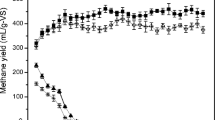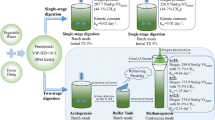Abstract
In this investigation, the Anaerobic Pump (®TAP) and a conventional continuous flow stirred tank reactor (CFSTR) were tested side by side to compare performance. TAP integrates anaerobic digestion (AD) with biogas plasticization–disruption cycle to improve mass conversion to methane. Both prototypes were fed a “real world” 50:50 mixture of waste-activated sludge (WAS) and primary sludge and operated at room temperature (20°C). The quantitative results from three steady states show TAP peaked at 97% conversion of the particulate COD in a system hydraulic residence time (HRT) of only 6 days. It achieved a methane production of 0.32 STP cubic meter CH4 per kilogram COD fed and specific methane yield of 0.78 m3 CH4 per cubic meter per day. This was more than three times the CFSTR specific methane yield (0.22 m3 CH4 per cubic meter per day) and more than double the CFSTR methane production (0.15 m3 CH4 per kilogram COD fed). A comparative kinetics analysis showed the TAP peak substrate COD removal rate (R o) was 2.24 kg COD per cubic meter per day, more than three times the CFSTR substrate removal rate of 0.67 kg COD per cubic meter per day. The three important factors contributing to the superior TAP performance were (1) effective solids capture (96%) with (2) mass recycle and (3) stage II plasticization–disruption during active AD. The Anaerobic Pump (®TAP) is a high rate, high efficiency–low temperature microbial energy engine that could be used to improve renewable energy yields from classic AD waste substrates like refuse-derived fuels, treatment plant sludges, food wastes, livestock residues, green wastes and crop residuals.


Similar content being viewed by others
Abbreviations
- Biobarrier line (B c):
-
A theoretical line corresponding to the maximum methane production for conventional digestion AD, generally located at the nexus of mesophilic temperature extrapolations of (HRT)−1 vs. B to infinity (typically the B c ≈ B at 60 days ≈ B o).
- Partially fluidized suspension:
-
A mixed slurry suspension with a fluid velocity adequate to suspend of the lighter solids fraction (heavier solids gravity separate) of the particle size and density array during active anaerobic settling tests.
- Rechargeable biogas suspension:
-
Suspension of digesting solids by natural biogas production followed by gas withdrawal (decompression or disruption) and then recharging with natural AD gas production, repeated in a continuous cycle.
- MPR:
-
Methane production rate (liters STP CH4 per day)
- GPR:
-
Biogas production rate (liters STP CH4 per day)
- TKN:
-
Total Kjeldahl (organic) nitrogen (grams nitrogen per liter)
- OLR:
-
Organic loading rate (kg TVS m−3 day−1 or kg COD m−3 day−1)
- pCOD:
-
Particulate chemical oxygen demand (gram particulate COD per liter)
- pN:
-
Particulate nitrogen concentration (gram particulate nitrogen per liter)
- B :
-
Methane production at a given retention time (liters STP methane per gram COD added)
- B o :
-
Maximum methane production for retention time approaching infinity (liters STP methane per gram COD added)
- R :
-
Refractory coefficient is the decimal fraction representing the proportion of substrate COD that is non-biodegradable (refractory) at infinite digestion time.
- R o :
-
Substrate removal rate function, either Monod or Contois (gram COD per liter day)
- S o :
-
The initial COD concentration at time t = 0 (gram COD per liter)
- S t :
-
Total COD concentration at any time t (grams COD per liter)
- S bo :
-
Maximum biologically available COD concentration in the feed (grams COD per liter)
- S to :
-
Total chemical oxygen demand (COD) concentration in the feed (grams COD per liter)
- S :
-
Effluent COD concentration (grams COD per liter)
- S i :
-
Concentration of particulate COD recycle + influent mixture (grams pCOD per liter)
- K :
-
Contois kinetic constant (dimensionless, gram COD substrate per gram COD organisms)
- K s :
-
Monod substrate saturation coefficient (grams COD per liter)
- Q :
-
The flow rate into the reactor (liters/day)
- Q r :
-
Recycle flow rate for TAP = 40 l day−1 for the project (all three TAP steady states)
- α :
-
QrQ−1 = the recycle ratio
- \( \widehat{\mu } \) :
-
Monod and Contois maximum growth rate (day−1)
- θ :
-
Hydraulic retention time (days)
- X :
-
In reactor cell mass concentration (gram/liter)
References
Boone, D. R. (1976). Fermentation reactions of anaerobic digestion. In P. N. Cheremisinoff & R. P. Ouellette (Eds.), Biotechnology handbook. Edmonton: Alberta Research Council.
Dague, R. R. (1970). Solids retention in anaerobic waste treatment systems. Journal of the Water Pollution Control Federation, 42, 29–46.
Chen, Y. R., & Hashimoto, A. G. (1978). Kinetics of methane fermentation. Biotechnology and Bioengineering Symposium, 8, 269–282.
Chen, Y. R., et al. (1979). Anaerobic fermentation of animal manure. St. Joseph, MI: ASAE.
Schimel, K. A. (1980). Anaerobic vacuum digestion of raw waste activated sludge. PhD dissertation, Syracuse University Department of Civil Engineering, Syracuse University, Syracuse. p. 466.
Knezevic, Z., Mavinic, D. S., & Anderson, B. C. (1995). Pilot scale evaluation of anaerobic codigestion of primary and pretreated waste activated sludge. Water Environment Research, 67(5), 835–841. doi:10.2175/106143095X131763.
Gert, L., et al. (2004). Advanced anaerobic bioconversion of lignocellulosic waste for bioregenerative life support following thermal water treatment and biodegradation by Fibrobacter succinogenes. Biodegradation, 15, 173–183. doi:10.1023/B:BIOD.0000026515.16311.4a.
Erickson, A. H., & Knopp, P. V. (1972). Biological treatment of thermally conditioned sludge liquors. Advances in water pollution research. Oxford: Pergamon.
Corrie, K. D., & Wycombe, R. D. C. (1972). Use of activated carbon in the treatment of heat treatment plant liquor. Water and Pollution Control, 71, 629–635.
Fischer, W. J., & Swanwick, J. D. (1971). High temperature treatment of sewage sludges. Water and Pollution Control, 70, 355–373.
Yue, Z.-B., et al. (2008). Enhanced anaerobic ruminal degradation of bulrush through steam explosion pretreatment. Industrial & Engineering Chemistry Research, 47, 5899–5905. doi:10.1021/ie800202c.
Xie, R., et al. (2007). Full-scale demonstration of an ultrasonic disintegration technology in enhancing anaerobic digestion of mixed primary and thickened secondary sewage sludge. Journal of Environmental Engineering and Science, 6(5), 533. doi:10.1139/S07-013.
EIMCO. (2004). EIMCO Sonolyzer, sludge disintegration and minimization. Australia: EIMCO, GL&V.
Rivard, C. J., & Nagle, N. J. (1995). Midwest research institute, assignee. Pretreament of microbial sludges. USA patent 5,380,445.
Onyeche, T. I., & Schäfer, S. (2003). Sludge homogenisation as a means to reduce sludge volume and increase energy production. Electronic Journal of Environmental, Agricultural and Food Chemistry, 2(2), 291–296.
USEPA. (1974). Process design manual for sludge treatment and disposal. Washington, DC: OTT.
Rivard, C. J., Nagle, N. J., & Midwest Research Institute. (Kansas City, MI), assignee. 1998. Pretreatment of high solids microbial sludges. USA patent 5,785,852.
Liu, H. W., et al. (2002). Steam pressure disruption of municipal solid waste enhances anaerobic digestion kinetics and biogas yield. Biotechnology and Bioengineering, 77(2), 121–130. doi:10.1002/bit.10130.
Weemaes, M. P. J., & Verstraete, W. H. (1998). Review: evaluation of current wet sludge disintegration techniques. Journal of Chemical Technology and Biotechnology (Oxford, Oxfordshire), 73, 83–92. doi:10.1002/(SICI)1097-4660(1998100)73:2<83::AID-JCTB932>3.0.CO;2-2.
Metcalf & Eddy Inc. (2003). Wastewater engineering: treatment and reuse. 4th ed. In G. Tchobanoglous, F. Burton, and H. David Stensel (Eds.). New York: McGraw-Hill Higher Education, p. 1848.
Narasimhan, B., & Peppas, N. A. (1996). On the importance of chain reptation in models of dissolution of glassy polymers. Macromolecules, 29(9), 3283–3291. doi:10.1021/ma951450s.
Narasimhan, B., & Peppas, N. A. (1996). Disentanglement and reptation during dissolution of rubbery polymers. Journal of Polymer Science. Polymer Physics Edition, 34(5), 947–961. doi:10.1002/(SICI)1099-0488(19960415)34:5<947::AID-POLB13>3.0.CO;2-B.
Sears, J. K., & Darby, J. R. (1982). The technology of plasticization. New York: Wiley.
Soeradji, S. (1972). Mechanisms of ammonia sorption by Wood. Syracuse: SUNY ESF Department of Wood Products Engineering, SUNY Environmental Science and Forestry (p. 143).
Peterson, R. C. (1972). Defibering ammonia plasticized wood chips and the effect of drying from NH3 on pulp properties. Syracuse: Department of Wood Products Engineering, SUNY Environmental Science and Forestry.
Schimel, K. A. (2007). Biogas plasticization coupled anaerobic digestion: batch test results. Biotechnology and Bioengineering, 97(2), 297–307.
Finney, C. D. (1975). Anaerobic digestion: The rate limiting process and the nature of inhibition. Science, 190, 1088–1089.
Finney, C. D., et al. (Ed.) (1976). The fast production of methane by anaerobic digestion. Washington, DC: US Energy Research Development Administration.
Ort, J. E. (1976). High quality methane gas through modified anaerobic digestion. US patent 3981800, September 21, 1976.
Kapp, H. (1992). The effect of higher pressures on the mesophilic and the thermophilic anaerobic sludge digestion. In Proceedings Int. Symp. on anaerobic digestion of solid waste, Venice.
Vavilin, V. A., Vasiliev, V. B., & Rytov, S. V. (1995). Modelling of gas pressure effects on anaerobic digestion. Bioresource Technology, 52, 25–32. doi:10.1016/0960-8524(94)00148-T.
Schimel, K. A. (2006). Biogas plasticization coupled anaerobic digestion: Batch test results. Biotechnology and Bioengineering, 97, 297–307. doi:10.1002/bit.21227.
Boone, D. R., & Schimel, K. A. (2001). Final report: The anaerobic pump prototype testing. Sacremento: California Energy Commission.
USDOE EERE. (2002). Anaerobic pump. Washington, DC: DOE.
Schimel, K. A. (1983). Method for the treatment of organic material and particularly sewage sludge. U.S. patent 4,375,412.
Schimel, K. A. (1983). Systems for the treatment of organic material and particularly sewage sludge. US patent 4,401,565.
Schimel, K. A. (1987) Method for the treatment of organic material and particularly sewage sludge. US patent 4,642,187.
Schimel, K. A. (2003). Apparatus, system, and process for anaerobic conversion of biomass slurry to energy. US patent 6,663,777.
Speece, R. E. (1977). Gas flow totalizer. USA patent 4,064,750, Dec. 27, 1977.
APHA (1999). Standard methods for the examination of water and wastewater, 20th edn. In A.E. Greenburg (Ed.), Washington, DC: APAA, AWWA, and WPCF, p. 742.
Boone, D. R., et al. (1987). Effects of hydrogen pressure during growth and effects of pregrowth with hydrogen on acetate degradation by methanosarcina species. Applied and Environmental Microbiology, 53(1), 83–87.
Monod, J. (1949). The growth of bacterial cultures. Annual Review of Microbiology, 3, 371–394.
Michaelis, L., & Menten, M. L. (1913). Die Kinetik der Invertinwirkung. Biochemische Zeitschrift, 49, 333.
Bailey, J. E., & Ollis, D. F. (1986). Biochemical engineering fundamentals (2nd ed.). New York: McGraw-Hill.
O’Rourke, J. T. (1968). Kinetics of anaerobic waste treatment at reduced temperatures. PhD thesis, Department of Civil Engineering, Stanford University, Stanford, p. 214.
Vieira, L. G. T., Zaiat, M., & Foresti, E. (1997). Intrinsic kinetic parameters of substrate utilization by anaerobic sludge along the horizontal-flow anaerobic immobilized sludge (HAIS) reactor. Environmental Technology, 18(9), 953–957. doi:10.1080/09593331808616615.
Hobson, P. N., Bousfield, S., & Summers, R. (1974). Anaerobic digestion of organic matter. CRC Critical Review in Environmental Control, 4, 134.
California Energy Commission. (2002). The anaerobic pump prototype testing: Feasibility analysis. In H. Clark (Ed.), San Diego: San Diego State University Foundation, p. 11.
Acknowledgements
The authors would like to thank US DOE Invention and Innovation (EERE, http://www.eere.energy.gov/inventions/pdfs/techmatrixcorp.pdf) and the California Energy Commission (EISG, http://eisg.sdsu.edu/shortsums/shortsum9938.htm) for supporting this work. This article is dedicated to the project’s principle investigator, the late Dr. David R. Boone (http://www.pdx.edu/profiles/6252/).
Author information
Authors and Affiliations
Corresponding author
Additional information
David R. Boone, deceased May 2005.
Rights and permissions
About this article
Cite this article
Schimel, K.A., Boone, D.R. Biogas Plasticization Coupled Anaerobic Digestion: Continuous Flow Anaerobic Pump Test Results. Appl Biochem Biotechnol 160, 912–926 (2010). https://doi.org/10.1007/s12010-009-8652-6
Received:
Accepted:
Published:
Issue Date:
DOI: https://doi.org/10.1007/s12010-009-8652-6




